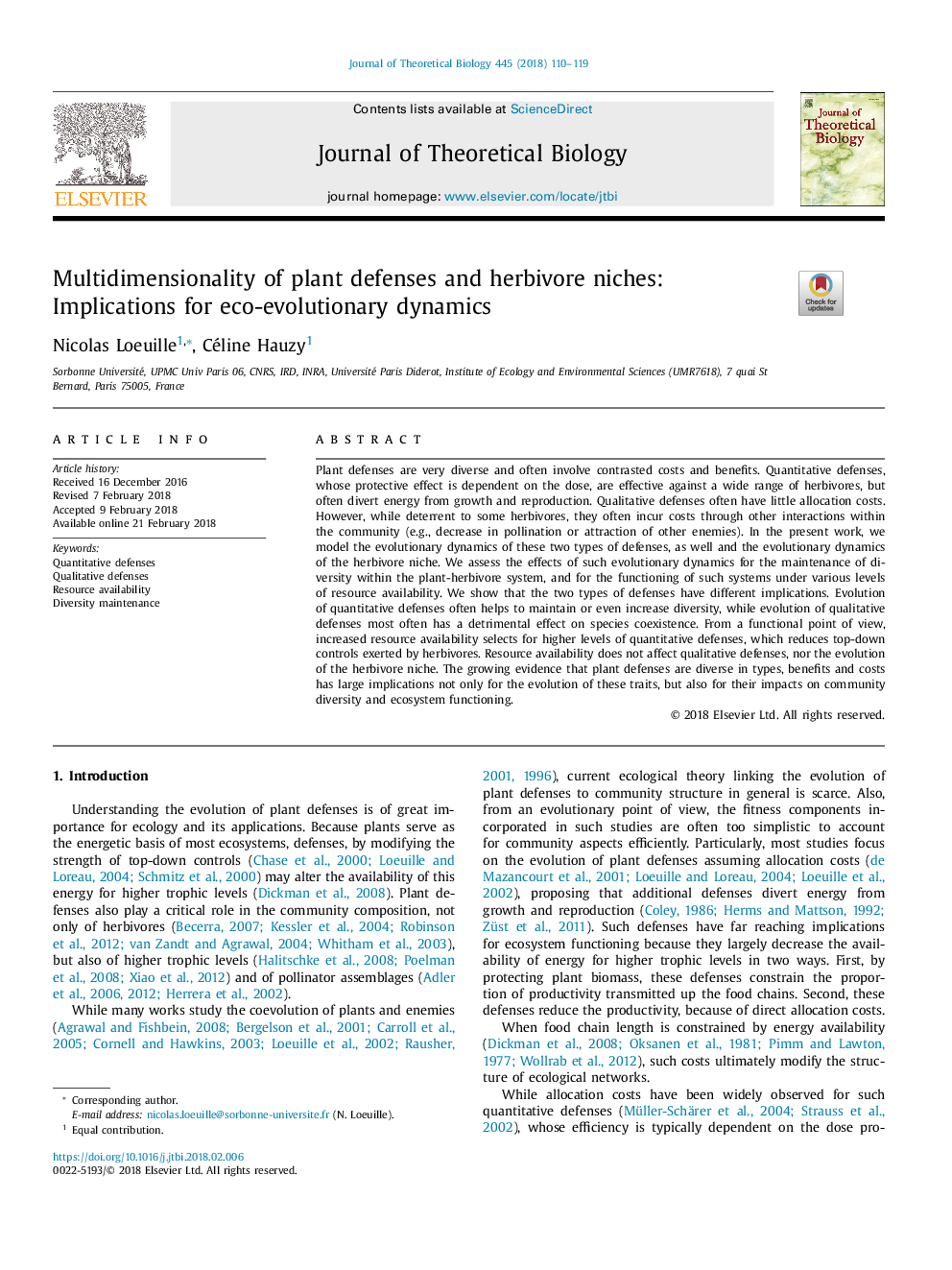| کد مقاله | کد نشریه | سال انتشار | مقاله انگلیسی | نسخه تمام متن |
|---|---|---|---|---|
| 8876763 | 1623765 | 2018 | 10 صفحه PDF | دانلود رایگان |
عنوان انگلیسی مقاله ISI
Multidimensionality of plant defenses and herbivore niches: Implications for eco-evolutionary dynamics
ترجمه فارسی عنوان
چندبعدی گیاهان دفاع و گیاهان زراعی: پیامدهای دینامیک تکاملی زیست
دانلود مقاله + سفارش ترجمه
دانلود مقاله ISI انگلیسی
رایگان برای ایرانیان
کلمات کلیدی
دفاع کم دفاع کیهانی، در دسترس بودن منابع، نگهداری تنوع
ترجمه چکیده
دفاع از گیاهان بسیار متنوع است و اغلب شامل هزینه ها و منافع متضاد است. دفاعی کم، اثر حفاظتی آن بستگی به دوز دارد، در برابر طیف وسیعی از گیاهخواران موثر است، اما اغلب انرژی را از رشد و تولید مثل منحرف می کند. دفاع های کیفی اغلب هزینه های تخصیص کمتری دارند. با این حال، در حالی که بازدارنده برخی از گیاهخواران است، اغلب هزینه های آنها را از طریق سایر تعاملات درون جامعه (از جمله کاهش گرده افشیدن یا جذب دشمنان دیگر) هزینهای می گیرند. در این مقاله، ما دینامیک تکاملی این دو نوع دفاع را نیز مدلسازی می کنیم و دینامیک تکاملی طاقچه گیاهان را نیز مدل می کنیم. ما اثرات چنین پویایی تکاملی را برای حفظ تنوع در سیستم گیاهخواری و عملکرد این سیستم ها در سطوح مختلف دسترسی به منابع ارزیابی می کنیم. ما نشان می دهیم که دو نوع دفاع دارای معانی متفاوت هستند. تکامل دفاعی کمی اغلب به حفظ و یا حتی افزایش تنوع کمک می کند، در حالیکه تکامل از دفاع کیفی اغلب تاثیر مخربی بر همزیستی گونه ها دارد. از دیدگاه کارکردی، دسترسی به منابع افزایش یافته برای سطوح بالاتری از دفاعهای کمی را انتخاب می کند، که کنترل های بالا و پایین توسط اعضای گیاهخوار را کاهش می دهد. در دسترس بودن منابع تاثیری بر دفاع کیفی و تکامل طغیان گیاهان ندارد. شواهد رو به رشدی که نشان می دهد که دفاع از گیاه در انواع، مزایا و هزینه ها متنوع است، نه تنها برای تکامل این صفات، بلکه برای تاثیرات آنها بر تنوع اجتماعی و عملکرد اکوسیستم ها نیز بستگی دارد.
موضوعات مرتبط
علوم زیستی و بیوفناوری
علوم کشاورزی و بیولوژیک
علوم کشاورزی و بیولوژیک (عمومی)
چکیده انگلیسی
Plant defenses are very diverse and often involve contrasted costs and benefits. Quantitative defenses, whose protective effect is dependent on the dose, are effective against a wide range of herbivores, but often divert energy from growth and reproduction. Qualitative defenses often have little allocation costs. However, while deterrent to some herbivores, they often incur costs through other interactions within the community (e.g., decrease in pollination or attraction of other enemies). In the present work, we model the evolutionary dynamics of these two types of defenses, as well and the evolutionary dynamics of the herbivore niche. We assess the effects of such evolutionary dynamics for the maintenance of diversity within the plant-herbivore system, and for the functioning of such systems under various levels of resource availability. We show that the two types of defenses have different implications. Evolution of quantitative defenses often helps to maintain or even increase diversity, while evolution of qualitative defenses most often has a detrimental effect on species coexistence. From a functional point of view, increased resource availability selects for higher levels of quantitative defenses, which reduces top-down controls exerted by herbivores. Resource availability does not affect qualitative defenses, nor the evolution of the herbivore niche. The growing evidence that plant defenses are diverse in types, benefits and costs has large implications not only for the evolution of these traits, but also for their impacts on community diversity and ecosystem functioning.
ناشر
Database: Elsevier - ScienceDirect (ساینس دایرکت)
Journal: Journal of Theoretical Biology - Volume 445, 14 May 2018, Pages 110-119
Journal: Journal of Theoretical Biology - Volume 445, 14 May 2018, Pages 110-119
نویسندگان
Nicolas Loeuille, Céline Hauzy,
